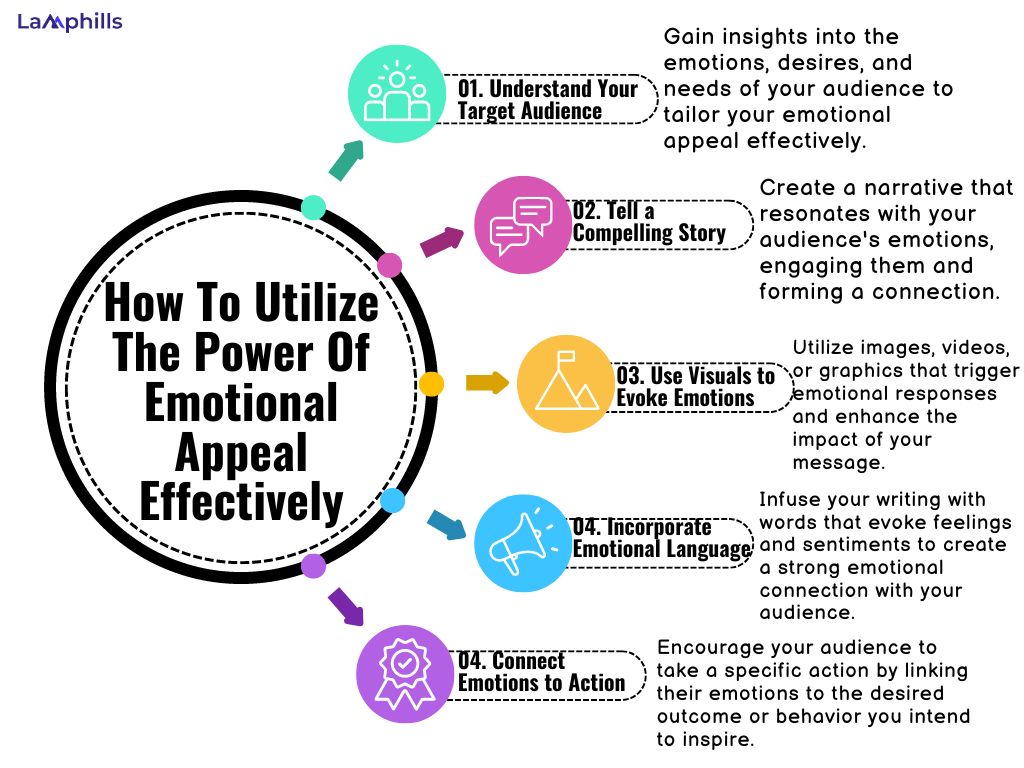In marketing and communication, the power of emotional appeal cannot be underestimated. Imagine where a simple image or story evokes strong feelings of joy, sadness, or nostalgia in your audience, instantly capturing their attention and forming a deep connection. Understanding how to effectively utilize emotional appeal can be a game-changer in influencing consumer behavior and creating lasting brand loyalty. Here, I’ll explore the art of emotional appeal and provide insights on how to harness its power effectively. This includes an example of emotional appeal Ad and fallacy examples.
So, by the end of this article, you’ll get valuable insights and practical tips to master emotional appeal and propel your communication efforts to new heights.
Key Points
- Emotional appeal is a powerful tool that can be effectively utilized in various forms of communication to connect with audiences on a deeper level.
- It uses narratives and personal experiences to help evoke emotions and create a connection with your audience.
- Visual elements such as photos or videos aren’t excluded, as they enhance the emotional impact of your message.
- Encouraging your audience to take action based on their emotional response can lead to a more significant impact on their behavior.
- Even genuine emotions are more likely to resonate with your audience and build trust.
What Is Emotional Appeal?
As the wise saying goes, “The soul has reasons that reason does not understand.” This quote by Blaise Pascal captures the essence of emotional appeal, a powerful tool that speaks directly to our innermost feelings and emotions.
Emotional appeal is a persuasive technique in communication to evoke strong emotions in the audience. This includes compassion, joy, fear, anger, or excitement. It aims to connect with individuals on a personal and heartfelt level, rather than relying solely on logic or facts. This approach taps into the emotional side of human nature, influencing beliefs, attitudes, and behaviors.
I have experienced the impact of emotional appeal. Whether it’s a heartfelt story that moves me to tears, a powerful image that stirs empathy within me, or a passionate speech that ignites a fire in my soul, I have felt the undeniable power of emotions in shaping my thoughts and actions.
Emotional appeal is often common in advertising, marketing, speeches, and storytelling to capture the attention and hearts of the audience. When used effectively, it can create a lasting impression and drive individuals to take action. However, use emotional appeal responsibly, ensuring your message is authentic, ethical, and respectful of your audience’s emotions.
What Are The Two Types Of Emotional Appeals?
There are two types of emotional appeals; positive emotional appeal and negative emotional appeal. Just like Maya Angelou’s wise saying, “People will forget what you said, people will forget what you did, but people will never forget how you made them feel”. This saying emphasizes the power of emotions in influencing our perceptions and memories.
Let me start with a positive emotional appeal. Positive emotional appeals aim to create feelings of happiness, joy, contentment or hope in the audience. For instance, when I see an advertisement featuring a family enjoying a meal together, it evokes a sense of warmth and togetherness in me. You can commonly see this type in marketing campaigns, where marketers associate a product or service with positive emotions. That’s making consumers more likely to make a purchase.
On the other hand, negative emotional appeals seek to provoke feelings of fear, anger, guilt, or sadness in the audience. For example, when I watch a public service announcement depicting the devastating effects of climate change, I feel a sense of urgency and concern. This type is often used to raise awareness about social issues. It can also be to encourage behavior change by highlighting the potential consequences of inaction.
That being said, both types of emotional appeals can be effective in influencing people’s attitudes and behaviors. Though, it depends on the context and the audience’s emotional response. Moreover, by tapping into our emotions, communicators can create a deeper connection with their audience and motivate them to take action.
What Are The Five Emotional Appeal?
As I stated earlier, in marketing and advertising, emotional appeal can be used to evoke feelings. This includes happiness, sadness, fear, love, or excitement to influence consumer behavior. Basically, they’re the five emotional appeals effective in connecting with others.
The first emotional appeal is love – the feeling of affection and attachment towards someone or something. When a message resonates with love, it can create a strong emotional bond and inspire actions based on positive emotions.
The second one is fear. Fear can evoke a sense of urgency and drive individuals to take action to avoid negative consequences. Hence, when you tap into people’s fears, your messages can persuade them to make decisions they believe will protect them from harm.
Another emotional appeal I find compelling is humor. Laughter is a universal language that can instantly create a positive connection. For example, using humor in communication can help to break down barriers, engage audiences, and make messages more memorable.
Sadness is also a powerful emotional appeal that can evoke empathy and compassion. When your message triggers feelings of sadness, your target audience may be motivated in many ways. They can be motivated to support a cause or take action to alleviate the suffering of others. To help you attract more customers, I recommend My Best Strategies For Audience Engagement With Free Template
Lastly, the emotional appeal of excitement can ignite enthusiasm and energy. Messages that evoke excitement can create a sense of anticipation and drive individuals to participate in experiences or activities that bring them joy and fulfillment.
To get more insights, read these articles SENSORY MARKETING: Best Strategies To Boost Your Brand Experience
Marketing vs. Advertising: Building a Growth Engine for Your Business
How To Utilize The Power Of Emotional Appeal Effectively
This reminds me of the first nonprofit organization I worked with. I was tasked with promoting a new environmentally friendly product, a reusable water bottle made from recycled materials. It wasn’t an easy task but I am glad I participated and learned lots of things, which I’ll share with you.
I know you’ll be eager to understand how to properly use emotional appeal to your audience. Don’t worry, I got you. To effectively utilize the power of emotional appeal in your promotional strategy, you can follow these steps:
#1. Understand Your Target Audience
First, research and analyze your target audience. Understand their needs, desires, and values. In the case of promoting a reusable water bottle, consider those most likely to reduce waste and support sustainable practices.
For instance, when I was promoting reusable water bottles, I found that our target audience consisted of environmentally conscious individuals who were passionate about reducing plastic waste. By understanding this, I was able to tailor our messaging to resonate with their values and concerns.
#2. Tell a Compelling Story
As I stated earlier, emotional appeal is often most effective when it is tied to a compelling story. For this reason, share the background and journey of your product in a way that evokes empathy and connection with the audience. Highlight how using the product can make a positive impact on the world or in their own lives.
For example, I incorporated the story of how the reusable water bottle was created to solve the problem of plastic pollution and promote sustainable living. You might be wondering what happened after that. Well, by sharing this story, we were able to create a sense of purpose and emotional connection with our audience. Isn’t it amazing? Of course, I advise you to always share a compelling story. Read this article How To Write a Human Interest Story: Detailed Guide
#3. Use Visuals to Evoke Emotions
“A picture is worth a thousand words.” This saying underscores the power of visual communication. That’s effectively conveying messages and evoking emotions in a way that words alone cannot.
Visual elements such as images and videos can be powerful tools to evoke emotions. For this reason, choose visuals that are not only appealing but also convey the emotional resonance you want to create. Also, show real people using the product in everyday situations or showcase the positive outcomes of using the product.
In our marketing campaign, we used images of happy families enjoying outdoor activities with their reusable water bottles. These visuals helped evoke feelings of joy, connection, and environmental responsibility among our audience.
#4. Incorporate Emotional Language
The language you use in your communication plays a significant role in appealing to emotions. With this, I mean to use words that trigger emotional responses such as love, happiness, hope, or pride. After that, frame your messaging in a way that speaks to the heart rather than just the mind.
In our promotional materials, we used some phrases. For example, “Join us in making a difference” and “Together, we can create a greener future.” These emotionally charged messages resonated with our audience and inspired them to take action.
#5. Connect Emotions to Action
Ultimately, the goal of utilizing emotional appeal is to motivate your audience to take action. Link the emotional connection you have established with the desired action. That’s whether making a purchase, signing up for a newsletter, attending an event, or supporting a cause.
Moreover, the key is to make the pathway from emotion to action as seamless and compelling as possible. By crafting a compelling narrative that resonates with your audience’s emotions and aligns with your goals, you can motivate them to not only feel a certain way but to also take the next step toward fulfilling your intended objective.

So, are you ready to explore emotional appeal in your business and trigger people to purchase your goods are services? then download the document below!
The Most Effective Emotional Appeal For Your Business
Emotional Appeal Ad
For emotional appeal ads, I believe they have the power to tap into our deepest feelings and connect with us on a personal level. These ads often use storytelling, music, or visuals that evoke emotions such as happiness, sadness, nostalgia, or inspiration. As a consumer, I am drawn to these types of ads because they make me feel something genuine and meaningful. Whether it’s a heartwarming commercial about family bonds or a poignant message about social issues, an emotional appeal ad has a way of leaving a lasting impression on me.
Furthermore, an emotional appeal ad can create a sense of empathy and understanding between the brand and the audience. By appealing to our emotions, these ads can build trust, loyalty, and a strong emotional bond with consumers. When a brand can make me feel something through their ad, I am more likely to remember their message and consider their products or services in the future. Hence, emotional appeal ad has a way of humanizing brands and showing their values and beliefs, which can resonate deeply with consumers like myself.
Emotional Appeal Example
I am a young lady trying to convince my younger brother to take driving safety seriously. As the eldest, I often find myself in situations where I need to appeal to my brother’s emotions to convey the importance of certain issues. One example of a strong emotional appeal I recently used with my brother was related to driving safety. I sat down with him and shared stories of real-life accidents involving young drivers who were not cautious on the road.
I described the devastating consequences these accidents had on the drivers, passengers, and their families. Also, I talked about the pain and suffering that could have been avoided if those drivers had been more responsible behind the wheel. Also, I shared my fears and worries about my brother’s safety every time he got behind the wheel.
So, with this emotional appeal example, I can see a shift in my brother’s attitude towards driving safety. He seemed more aware of the potential risks and pledged to be more careful and responsible on the road. This experience reinforced for me the power of emotional appeal in influencing behavior and decision-making, especially when it comes to issues as critical as driving safety.
Emotional Appeal Fallacy Examples
Emotional appeal fallacy, also known as an appeal to emotion, is a rhetorical tactic people often use to manipulate their audience’s sentiments rather than relying on logical reasoning. By evoking strong emotions they try to influence their audience’s decisions or beliefs. For this reason, I will share some emotional appeal fallacy examples for you to understand:
Political speeches often use emotional appeal to sway voters. For example, a candidate may invoke feelings of patriotism and national pride to gain support, rather than focusing on their policies and qualifications.
Advertisements frequently use emotional appeal to sell products. For instance, a commercial for a luxury car might emphasize the feelings of success and status associated with owning the vehicle, rather than its actual features and performance.
In debates or discussions, appealing to pity is a common emotional fallacy. For instance, someone may try to win an argument by making the other person feel guilty or sympathetic towards them, instead of presenting valid reasons or evidence.
In fundraising campaigns, charities often use emotional appeal to solicit donations. They may show images of suffering children or animals to evoke feelings of compassion and urgency, rather than providing detailed information on how the donations will be used effectively.
I know you must have encountered at least one of these emotional appeal fallacy examples. They can be powerful tools in persuading others, but I advise you not to use them as a substitute for sound reasoning and evidence-based arguments. Just be aware of these tactics to make informed and rational decisions.
How Do You Identify Emotional Appeal?
Identifying emotional appeal in a piece of writing involves recognizing language or tactics used to evoke feelings or sentiments in the audience. It’s like a subtle dance in which words play on the emotions of the reader without explicitly stating them. For instance, when an author uses descriptive language that aims to connect you on an emotional level rather than just providing facts or information, it’s likely to be employing emotional appeal.
Emotional appeal can take many forms. This includes storytelling, vivid imagery, personal anecdotes, or language laden with connotations that trigger specific emotional responses. So, it’s like a gentle tug at the heartstrings or a whisper in the mind that provokes a certain feeling or reaction in you.
By paying attention to the tone, language, and overall message conveyed in a writing, you can often identify the emotional appeal being used. It’s like unraveling a hidden thread that runs through the words, guiding you toward a particular emotional response or conclusion. So, next time you read something that stirs your emotions or makes you feel a certain way, take a step back and see if you can identify the emotional appeal at play.
What Is An Example Of An Emotional Appeal In Propaganda?
One example of an emotional appeal in propaganda is the use of heartbreaking images or stories to evoke empathy and compassion from the audience. For instance, showing pictures of starving children or victims of war can trigger emotions of sadness and guilt, prompting individuals to support a cause or take a specific action. By appealing to emotions rather than logic, propagandists can effectively manipulate people’s perceptions and decisions.
Why Is Emotional Appeal?
In my view, emotional appeal resonates with people because it taps into their feelings, values, and beliefs. When we appeal to emotions such as love, fear, happiness, or sadness, we can trigger a more profound response compared to merely presenting facts or logical arguments. As human beings, we are naturally drawn to stimuli that make us feel something. This is why emotional appeal can be so effective in influencing our thoughts and behaviors.
Moreover, emotions play a significant role in decision-making processes. By appealing to emotions, you can sway opinions, change attitudes, and inspire action. Whether it’s in advertising, public speaking, or writing, tapping into the emotional side of your audience can make the message more relatable and engaging.
Additionally, using emotional appeal in my writing has helped me connect with you (my readers) on a deeper level. Also, by sharing personal stories, using descriptive language, and creating a sense of empathy, I have been able to convey messages in a way that resonates with you.
Why Use Emotional Appeals?
Imagine a nonprofit organization seeking donations to support children in need. They could simply present facts and figures about the children’s living conditions and the impact of donations. While this may appeal to some people’s logical side, it may not be enough to truly motivate individuals to take action. This is where emotional appeals come in.
Using emotional appeals can help create a personal connection with the audience by tapping into their feelings and values. By sharing stories of individual children and their struggles, the organization can evoke empathy and compassion in potential donors. Besides, when people feel emotionally moved, they are more likely to be motivated to support the cause and make a donation.
Note that emotional appeals are not only inform people about the cause but also to inspire them to take action and make a difference in the lives of the children in need. Emotions can be a powerful tool in communication and persuasion, as they can help people connect on a deeper level and ignite a desire to help others.
Related Articles
SENSORY MARKETING: Best Strategies To Boost Your Brand Experience
WHAT CAN YOU DO TO MAKE A HEADLINE MORE COMPELLING? Content Hacks 101






